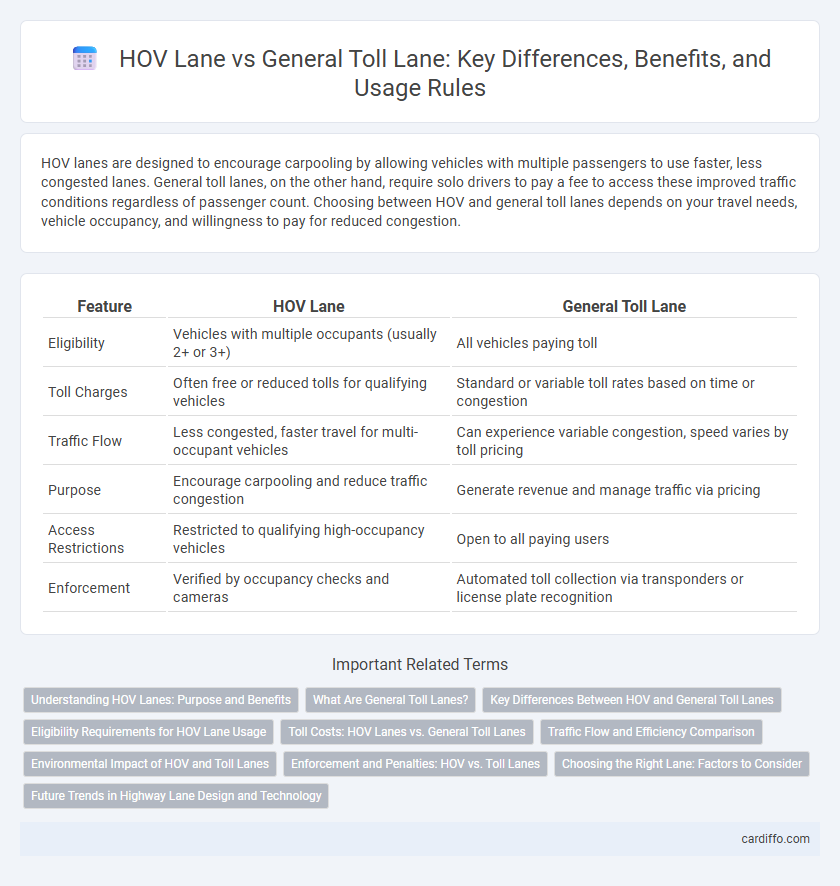HOV lanes are designed to encourage carpooling by allowing vehicles with multiple passengers to use faster, less congested lanes. General toll lanes, on the other hand, require solo drivers to pay a fee to access these improved traffic conditions regardless of passenger count. Choosing between HOV and general toll lanes depends on your travel needs, vehicle occupancy, and willingness to pay for reduced congestion.
Table of Comparison
| Feature | HOV Lane | General Toll Lane |
|---|---|---|
| Eligibility | Vehicles with multiple occupants (usually 2+ or 3+) | All vehicles paying toll |
| Toll Charges | Often free or reduced tolls for qualifying vehicles | Standard or variable toll rates based on time or congestion |
| Traffic Flow | Less congested, faster travel for multi-occupant vehicles | Can experience variable congestion, speed varies by toll pricing |
| Purpose | Encourage carpooling and reduce traffic congestion | Generate revenue and manage traffic via pricing |
| Access Restrictions | Restricted to qualifying high-occupancy vehicles | Open to all paying users |
| Enforcement | Verified by occupancy checks and cameras | Automated toll collection via transponders or license plate recognition |
Understanding HOV Lanes: Purpose and Benefits
HOV lanes, or High-Occupancy Vehicle lanes, are designed to encourage carpooling and reduce traffic congestion by allowing vehicles with multiple passengers to travel at higher speeds or toll-free during peak hours. Unlike general toll lanes that charge all vehicles a fee regardless of occupancy, HOV lanes provide a cost-saving incentive while promoting environmental benefits through decreased emissions. These lanes effectively improve roadway efficiency and contribute to decreased travel times for commuters sharing rides.
What Are General Toll Lanes?
General toll lanes are express lanes open to all vehicles that require a fee for access, unlike HOV lanes which prioritize high-occupancy vehicles. These lanes are designed to manage traffic flow and reduce congestion by providing a reliable, faster travel option for drivers willing to pay the toll. Electronic toll collection systems, such as transponders, are commonly used to facilitate seamless payment and maintain free-flow conditions in general toll lanes.
Key Differences Between HOV and General Toll Lanes
HOV lanes are reserved for vehicles with multiple occupants, promoting carpooling and reducing traffic congestion, while general toll lanes allow all vehicles to use the lane for a fee regardless of occupancy. Toll rates in general lanes vary dynamically based on traffic conditions, encouraging efficient use of road capacity, whereas HOV lanes often have lower or no tolls to incentivize high-occupancy vehicle usage. Enforcement methods differ as HOV lanes require monitoring passenger counts, and general toll lanes rely on electronic toll collection systems for seamless payment.
Eligibility Requirements for HOV Lane Usage
HOV lanes require vehicles to meet specific occupancy criteria, typically mandating two or more passengers, to qualify for access without paying tolls. High-occupancy vehicle lane eligibility often includes carpools, vanpools, motorcycles, and sometimes exemptions for certain clean fuel or emergency vehicles. General toll lanes impose fees on all vehicles regardless of occupancy, making HOV lanes a cost-effective option for eligible multi-passenger vehicles.
Toll Costs: HOV Lanes vs. General Toll Lanes
HOV lanes typically offer reduced or waived toll costs to encourage carpooling and reduce traffic congestion, while general toll lanes charge standard toll rates based on distance or time of use. The toll cost in general lanes varies depending on traffic demand, often increasing during peak hours through dynamic pricing to manage congestion. In contrast, HOV lanes prioritize vehicles with multiple occupants, resulting in lower or no toll fees that promote shared rides and decrease environmental impact.
Traffic Flow and Efficiency Comparison
HOV lanes prioritize high-occupancy vehicles, significantly reducing congestion and improving traffic flow during peak hours by encouraging carpooling and optimizing lane usage. General toll lanes, while generating revenue through tolls, often experience higher vehicle volumes and slower speeds due to mixed occupancy, leading to less efficient traffic movement. Studies indicate that HOV lanes achieve better average travel speeds and lower delay compared to general toll lanes, enhancing overall roadway efficiency and reducing emissions.
Environmental Impact of HOV and Toll Lanes
HOV lanes reduce vehicle emissions by encouraging carpooling and increasing occupancy per vehicle, which lowers overall fuel consumption and air pollution compared to general toll lanes. General toll lanes can help manage traffic flow and reduce congestion but may not significantly decrease emissions if single-occupancy vehicles continue to dominate. Implementation of HOV lanes combined with toll pricing strategies optimizes both traffic efficiency and environmental benefits by promoting sustainable transportation habits.
Enforcement and Penalties: HOV vs. Toll Lanes
HOV lanes enforcement relies on visual verification and automated camera systems to ensure compliance with occupancy requirements, with penalties ranging from fines to points on a driver's license. General toll lanes use electronic toll collection technologies like RFID and license plate recognition to monitor usage, imposing charges and hefty fines for toll evasion. Both systems aim to optimize traffic flow, but toll lane enforcement emphasizes financial penalties, while HOV lane enforcement targets vehicle occupancy violations.
Choosing the Right Lane: Factors to Consider
Choosing the right lane between HOV and general toll lanes depends on vehicle occupancy, time savings, and toll fees. HOV lanes prioritize vehicles with multiple passengers, offering reduced or no tolls for carpoolers while general toll lanes are available to all vehicles but charge variable fees based on traffic congestion. Drivers should evaluate travel time efficiency, cost, and eligibility criteria to maximize benefits and ensure compliance.
Future Trends in Highway Lane Design and Technology
Future trends in highway lane design emphasize the integration of HOV lanes with advanced tolling technologies to optimize traffic flow and reduce congestion. Dynamic pricing models combined with real-time data analytics will enable more efficient lane usage by adjusting toll rates based on demand and vehicle occupancy. Emerging technologies such as connected vehicle systems and smart infrastructure are set to enhance the seamless operation of both HOV and general toll lanes, promoting sustainability and improved commuter experience.
HOV Lane vs General Toll Lane Infographic

 cardiffo.com
cardiffo.com